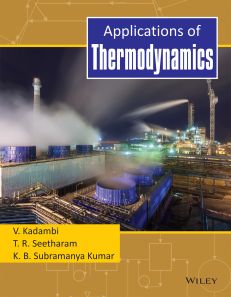Applications of Thermodynamics
ISBN: 9788126571246
Publication Year: 2019
eBook also available for institutional users
For more information write to us at: acadmktg@wiley.com

Description
Applications of Thermodynamics deals with the applications of first and second law of thermodynamics for various engineering systems. This book covers the entire course on Applied Thermodynamics as prescribed by almost all engineering colleges in India. Unique solving approach has been presented in the Solved Examples intending to help in quickly comprehending concepts as discussed in the book. Adequate number of thought-provoking and practical Exercises presented in this book will help students in analyzing any new problem in Applied Thermodynamics with confidence.
Preface
Acknowledgments
Symbols
Chapter 1 Review of Basic Thermodynamics
1.1 Introductory Concepts and Definitions
1.2 Work and Heat
1.3 First Law of Thermodynamics (Law of Conservation of Energy)
1.4 Second Law of Thermodynamics
1.5 Entropy
1.6 Pure Substances
1.7 Ideal Gases
Chapter 2 Reciprocating Gas Compressors
2.1 Introduction
2.2 Classification of Compressors
2.3 Working Principle of a Reciprocating Compressor
2.4 Classification of Reciprocating Compressors
2.5 Expression for Work Done in a Single-Stage Compressor without Clearance
2.6 Work Done in a Single-Stage Compressor
2.7 Volumetric Efficiency of a Reciprocating Compressor
2.8 Actual –Diagram for a Single-Stage Compressor
2.9 Performance Parameters for Reciprocating Compressors
2.10 Disadvantages of Single-Stage Compressors (Need for Multistage Compressors)
2.11 Work Done in a Second-Stage Compressor with Intercooling in between the Stages
2.12 Intermediate Pressure for Minimum Work of Compression
2.13 Optimum Intermediate Pressure for a Two-Stage Actual Compressor
Chapter 3 Vapor Power Cycle
3.1 Introduction
3.2 Carnot Vapor Power Cycle and Its Limitations
3.3 The Rankine Cycle (Ideal Simple Vapor Power Cycle)
3.4 Effects of Pressure and Temperature on the Performance of the Rankine Cycle
3.5 Reheat Cycle
3.6 Regenerative Vapor Power Cycle
3.7 Reheat-Regenerative Cycle
3.8 Deviations of Practical Cycles from Ideal Cycle
3.9 Characteristics of an Ideal Working Fluid for Vapor Power Cycles
3.10 Alternative Working Fluids for Rankine Cycle
3.11 Binary Vapor Cycle
3.12 Cogeneration Plant
3.13 Efficiencies of a Steam Power Plant
3.14 Organic Rankine Cycle
3.15 Supercritical Rankine Power Cycle
Chapter 4 Gas Power Cycles
4.1 Introduction
4.2 Analysis of Power Cycles
4.3 Carnot Gas Power Cycle
4.4 Air Standard Cycles
4.5 Air Standard Otto Cycle
4.6 Air Standard Diesel Cycle
4.7 Dual-Combustion Cycle or Semi-Diesel Cycle or Limited Pressure Cycle
4.8 Comparison between Otto, Diesel and Dual Combustion Cycles
4.9 Stirling Cycle
4.10 Atkinson Cycle
4.11 The Brayton Cycle
4.12 Brayton Cycle with Regenerator (Exhaust Heat Exchanger)
4.13 Gas Turbine Cycle with Multi-Stage Expansion (Reheat Cycle)
4.14 Gas Turbine Cycle with Multi-Stage Compression and Intercooling
4.15 Practical Gas Turbine Cycles
4.16 Gas Turbine Cycle for Jet Propulsion
4.17 Combined Brayton–Rankine Cycle
4.18 Brayton Cycle with Supercritical Carbon Dioxide
Chapter 5 Refrigeration Cycles
5.1 Introduction
5.2 Capacity and Coefficient of Performance of a Refrigerator
5.3 Refrigeration Cycles
5.4 Gas Refrigeration Cycles
5.5 Mechanical Vapor Compression Refrigeration Cycle
5.6 Common Refrigerants
5.7 Absorption Refrigeration Systems
5.8 Steam-Jet Refrigeration System
Chapter 6 Air-Conditioning
6.1 Introduction
6.2 Thermodynamics of Air–Water Vapor Mixture
6.3 Psychrometric Chart
6.4 Air-Conditioning Processes (Psychrometric Processes)
6.5 The Condition Line
6.6 Apparatus Dew Point
6.7 Bypass Factor
6.8 Cooling Towers
Chapter 7 Internal Combustion Engines
7.1 Introduction
7.2 Working of a Reciprocating IC Engine
7.3 Classification of Reciprocating IC Engines
7.4 Measurements and Testing of IC Engines
Chapter 8 Thermodynamics of Compressible Flow
8.1 Introduction
8.2 Sonic Velocity and Mach Number
8.3 Sonic Velocity for a Gaseous Medium
8.4 Static and Stagnation States of a Fluid
8.5 Effect of Area Variation on Pressure and Velocity for One-Dimensional Isentropic Flow through a Passage
8.6 Choking in Isentropic Flow and Critical Properties
8.7 Pressure Distribution and Choking in a Nozzle
8.8 Supersaturated Flow of Steam
Chapter 9 Thermodynamics of Reacting Mixtures
9.1 Introduction
9.2 Basic Chemistry
9.3 Fuels
9.4 Combustion Equations
9.5 Combustion with Air
9.6 Analysis of the Products of Combustion (Orsat Analysis)
9.7 Enthalpy of Formation
9.8 First Law Analysis of Combustion and Enthalpy of Combustion
9.9 Adiabatic Flame Temperature
9.10 Entropy Change for a Combustion Process
9.11 Second Law Analysis of a Combustion Process
Chapter 10 Availability Analysis of Thermodynamic Systems
10.1 Introduction
10.2 Reversible Work
10.3 Reversible Work in a Non-Flow Process (Closed System)
10.4 Useful Work
10.5 Reversible Work in a Flow Process
10.6 Reversible Work for a Steady Flow Process
10.7 Availability
10.8 Availability for a Flow Stream (Open System)
10.9 Irreversibility or Availability Destruction
10.10 Second Law Efficiency
10.11 Diffusion Availability
10.12 Availability Analysis for Combustion Processes
Multiple-Choice Questions
Theory Questions
Exercises
Appendix
Index

